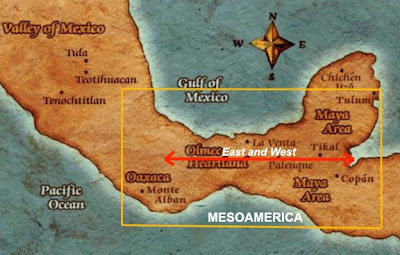As an example of words used in the Book of Mormon and their 1828 definition:
• Northward = Toward the North, nearer to the north than to the west or east.
As in “it being so far northward that it came into the land which had been peopled and been destroyed, of whose bones we have spoken…Thus the land on the northward was called Desolation, and the land on the southward was called Bountiful” (Alma 22:30-31).
This is definitely a direction as Mormon describes the Land of Promise; however, no skewing of the land mass of Mesoamerica can place it in a Northward or Southward direction. Actually, Mesoamerica itself is almost a perfect east-west direction.
 As can be seen from the above map of Mesoamerica, the actual area runs almost a perfect east-west, and not until you get beyond the western boundary does the land begin to move northward. But this is beyond the area described as the Land of Promise by Mesoamerican Theorists.
As can be seen from the above map of Mesoamerica, the actual area runs almost a perfect east-west, and not until you get beyond the western boundary does the land begin to move northward. But this is beyond the area described as the Land of Promise by Mesoamerican Theorists.• Steer = To guide, but also to correct or chide; to discipline; to support
As in “in them there is no light; whither shall we steer?” (Ether 2:19). Was the Brother of Jared asking the Lord for light so they could steer the ship which was driven by furious winds and currents, with no mention of a helm, and which was under the water at times and it would be the Lord who would bring them back to the surface (Ether 2:24; 6:10)? Or was he referring to light needed for those in the totally enclosed and sealed vessel to see, so they could carry out the needs of a year-long voyage—like preparing meals, caring for and feeding animals, and taking care of children? So they could steer--support one another?
• Sea = The ocean; a branch of the ocean
As in “the Lord has made the Sea our path, and we are upon an isle of the sea” (2 Nephi 10:20), thus indicating that the Nephites crossed an ocean and ended up on an island in the ocean.
This can hardly be the description of Mesoamerica, Central America, Baja California, New England, the Great Lakes, Heartland, or the Malaysia Peninsula. Yet many historian/scholars want to place the Land of Promise in these unsuitable places.
When Jacob says they were led across the ocean and settled on an island in the ocean, we need to find a place for the Land of Promise that qualifies as an island—an isle in the midst of the ocean. It is simply not appropriate to pick Mesoamerica because of its many ruins on the land; or pick the Great Lakes simply because it is located near the hill Cumorah; or to pick any other place simply because it seems to meet a single or a few criteria. For any site to even be considered, it first must be, or was, an island, and that ocean currents and winds would drive a sailing boat in 600 B.C. to it!
• Cattle = Beasts or quadrupeds in general; serving for tillage or other labor; for food of man (includes camels, asses, and all the variety of domesticated horned beasts of the bovine genus, sheep of all kind and goats and perhaps swine (generally includes horses, but not in New England)
As in “they had taken their horses, and their chariots, and their cattle, and all their flocks, and their herds, and their grain, and all their substance, and did march forth by thousands and by tens of thousands, until they had all gone forth to the place which had been appointed” (3 Nephi 22, also 4:4, 6:1), and in “all manner of cattle, of oxen, and cows, and of sheep, and of swine, and of goats, and also many other kinds of animals which were useful for the food of man” (Ether 9:18).
These cattle mentioned in the Book of Mormon are mentioned with other animals, as in flocks and herds, or oxen, horses, cows, goats, sheep and swine. Some Theorists like to claim it was only the “cattle” we think of today, that is, steers, and that there were no animals for tillage. However, the scriptural record tells us that cattle were mentioned with numerous other animals, including cows and oxen, as well as horses. Incidentally, since “cattle” in 1828 included camels and cameloid animals, and these are referred to as “flocks,” it might give us an indication that the Jaredites brought such with them to the Land of Promise.
(See next post, “Understanding Words in the Book of Mormon about the Land of Promise—Part IV” for more understanding of the words Joseph knew when translating the Book of Mormon)




No comments:
Post a Comment